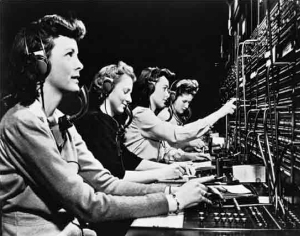- Home
- Services
- Hi-Line Engineering
- About
- Careers
- Contact
- Requests For Proposals
Utility Communications in Regional Transmission Organizations -
by GDS Associates, Inc | January 19, 2016 | Newsletter - TransActions
 As each RTO has evolved and matured its control and market models, the required quantity of data exchanged has grown and the accuracy and reliability requirements of that data have become increasingly important. Constructing a working, reliable, secure, and cost effective communications network that provides for the needs of the RTO, the Local Balancing Authority (LBA), generation power plants, and the electric utilities is a difficult task to accomplish. In some ways, communication systems have come a long ways from the early 1900’s “cordboard”; however, electric utilities face some complex RTO communications requirements in order to exchange data as well as developing and maintaining an integrated communications system.
As each RTO has evolved and matured its control and market models, the required quantity of data exchanged has grown and the accuracy and reliability requirements of that data have become increasingly important. Constructing a working, reliable, secure, and cost effective communications network that provides for the needs of the RTO, the Local Balancing Authority (LBA), generation power plants, and the electric utilities is a difficult task to accomplish. In some ways, communication systems have come a long ways from the early 1900’s “cordboard”; however, electric utilities face some complex RTO communications requirements in order to exchange data as well as developing and maintaining an integrated communications system.
Constructing a working, reliable, secure, and cost effective communications network that provides for the needs of the RTO, the Local Balancing Authority (LBA), generation power plants, and the electric utilities is a difficult task to accomplish.
What data needs to be exchanged between each utility and the RTO ?
In order to manage and keep its transmission network stable, each RTO now requires most or all of the following data to be exchanged – every two seconds – with every connected Utility, Power Plant (POI), and/or Substation (POD) in its region:
- Switching Device Status (Open/Closed)
- Line and Transformer flow (MW and MVAR)
- Circuit breaker flow (MW and MVAR)
- Net or Gross Generation (MW and MVAR)
- Generation Auxiliaries (MW and MVAR)
- Synchronous Condenser and SVC (MVAR)
- Load (MW and MVAR)
- Bus Voltage magnitudes (kV)
- Tap positions of transformers and phase shifters
- Type II DRRs (MW and MVAR)
- Plant Control Mode (0, 1, 2, or 3)
- Generator Voltage Regulation status (On AVR, Off AVR). AVR: Automatic Voltage Regulation (Optional)
- Power System Stabilizer software (PSS enabled, PSS disabled) (Optional)
- Synchronous Condenser status (On AVR, Off AVR) (Optional)
- Transformer status (On AVR, Off AVR) (Optional)
- Shunt Capacitor/Reactor status (On AVR, Off AVR) (Optional)
- Net Generation Set Point (MW) (five minute interval)
- Generator Ramp Rates (MW/minute)
- Raise / Lower Output of a Generator
In addition, accumulated hourly MWh and MVARh data and hourly offer curves must be submitted daily.
How is the data exchanged between a utility and a RTO?
Each RTO has developed a set of standards by which each connected utility is required to communicate. [see Figure 2] Usually the RTO will provide:
- Two, high speed, point-to-point network connections (T1’s or equivalent) via two different service providers (for reliability);
- An Internet link for 5-minute back-up and daily data submission to each utility, and;
- Defined communication protocols that are used to exchange data (often ICCP as primary and XML as back-up/daily submission).
Most power plants and substations are already interconnected to a utility-wide System Control and Data Acquisition (SCADA) system through that utility’s own communications infrastructure, so most additional network connections to the RTO and required protocols are just one more piece of an existing communications network; but some aren’t. Some electric utilities and/or IPP owned power plants are still receiving their run schedules by phone, fax, and email and, for them, operating in a new, integrated market environment brings new communication challenges.
Full service electric utilities effectively operate and maintain at least three separate, internal, data networks – a business Local Area Network (LAN), a generation control LAN, and a transmission control LAN. (For security, reliability, and competitive market issues, none of them are allowed to share data directly with the others.) Also, each RTO maintains at least four different business and control models (in addition to system models developed for long range planning) to balance loads, resources, and the transmission system: a Day-Ahead / Real Time model, a commercial model, a network model, and a Financial Transmission Rights (FTR) model. Each of these RTO models needs to exchange data with one or more of the utility networks throughout the day, every day, in order for 1) the RTO to maintain network stability, 2) the connected utilities to make the adjustments to their equipment as directed by the RTO and, 3) the RTO to calculate costs for settlements.
RTO Connection Requirements for Electric Utility, Power Plant, or Load
When an electric utility, power plant or load (that isn’t already connected to an RTO) chooses to (or is required to) connect to an RTO, it must set up a highly reliable data hub and network capable of accommodating at least two independent, point-to-point data paths and an Internet connection to the RTO and redundant, independent, network connections to each plant and/or load (if not already in place). Technically, this data hub will require separate routers, firewalls, and servers for each data path and Internet connection to the RTO, secure communications with each power plant and load and must be able to 1) gather all of the required data, 2) convert it into the format and protocol specified by the RTO (usually ICCP with XML back-up), 3) send it to the RTO over secure data lines, 4) receive control data from the RTO, 5) convert it to a format the utility, plant and/or load control system can understands, and 6) disseminate the information to the various controls systems so they can react to the orders from the RTO.

Financially, this type of data hub communications system can require a significant investment (the costs vary based on a variety of factors and options chosen) but the risks of not “hardening” the data hub include missed opportunities, “failure to perform” costs, and even fines.
The challenges of installing or upgrading an existing electric utility communications network and data center include:
- Working with the service providers to balance connectivity speed, reliability, and cost.
- Compliance with existing and planned NERC requirements.
- Assurance that the chosen service providers don’t install their communications lines in one common right-of-way (thus risking disruption of all connections to the data center by one mistake).
- Forward consideration of analog vs. digital connectivity (e.g. the FCC is considering granting permission to service providers to shut down the existing switched (analog) networks around the year 2020).
- Surprises in existing POTS and network connections requiring repairs and upgrades. (i.e. finding solutions to previously unresolved problems as well as addressing updated codes)
- High Voltage Protection (HVP) – AT&T and other communication service providers now require that a ground fault study be performed and safety equipment installed to isolate their equipment and personnel in case of a fault at the power plant or substation site.
There are three IEEE standards that apply for HVP:
- IEEE 367, Recommended Practice for Determining the Electric Power Station Ground Potential Rise and Induced Voltage From a Power Fault
- IEEE Std 487, IEEE Recommended Practice for the Protection of Wire-Line Communication Facilities Serving Electric Supply Locations
- IEEE Std 80, IEEE Guide for Safety in AC Substation Grounding
While these complex networks generally enhance reliability and efficiency, they do present challenges to utilities and an effective and integrated communications plan can help utilities meet those challenges.
Many mature RTOs (MISO, PJM, etc.) have already evolved to the integrated market model and issued communications protocols; however, there are many RTOs and potential RTOs in the process of developing communications requirements, so it will be important for utilities to stay abreast of and/or participate in the development of these requirements. The key issues for electric utilities that are going to be operating in an RTO environment are:
1) Evaluate their existing communications networks, 2) Develop transition plans the meet their current and foreseen needs, and 3) Support the implementation of these plans either by direct project management or oversight of contractors.
In the beginning (of the electrical industry evolution), power plants stood alone, fed some distribution lines, and customers had lights, fans, and pumps – and life was simple and good. Today, most of our load requirements and power supply arrangements are managed by RTO’s through a complex communications network owned and operated by a combination of the RTO’s, communications service providers, and electric utilities. While these complex networks generally enhance reliability and efficiency, they do present challenges to utilities and an effective and integrated communications plan can help utilities meet those challenges.
For more information or to comment on this article, contact:
 Hunt Armistead, Senior Project Manager | CONTACT
Hunt Armistead, Senior Project Manager | CONTACT
GDS Associates, Inc. – Austin, TX
512.541.3165
GET OUR NEWSLETTER
RECENT POSTS
Archives
- December 2015 (8)
- January 2016 (6)
- July 2016 (6)
- March 2021 (6)
- May 2022 (6)
- August 2020 (5)
- March 2015 (4)
- January 2019 (4)
- June 2019 (4)
- August 2019 (4)
- February 2020 (4)
- May 2020 (4)
- June 2020 (4)
- December 2020 (4)
- July 2021 (4)
- October 2021 (4)
- April 2015 (3)
- August 2016 (3)
- February 2017 (3)
- July 2017 (3)
- February 2018 (3)
- February 2019 (3)
- November 2019 (3)
- March 2020 (3)
- April 2020 (3)
- September 2021 (3)
- December 2021 (3)
- August 2022 (3)
- December 2022 (3)
- April 2023 (3)
- July 2023 (3)
- December 2023 (3)
- May 2014 (2)
- February 2016 (2)
- March 2016 (2)
- September 2016 (2)
- November 2016 (2)
- January 2017 (2)
- July 2018 (2)
- November 2018 (2)
- March 2019 (2)
- May 2019 (2)
- July 2020 (2)
- September 2020 (2)
- April 2021 (2)
- August 2021 (2)
- February 2014 (1)
- April 2014 (1)
- July 2014 (1)
- August 2014 (1)
- November 2014 (1)
- February 2015 (1)
- May 2015 (1)
- June 2015 (1)
- November 2015 (1)
- October 2016 (1)
- December 2016 (1)
- October 2018 (1)
- December 2018 (1)
- April 2019 (1)
- July 2019 (1)
- September 2019 (1)
- October 2020 (1)
- November 2020 (1)
- February 2021 (1)
- April 2022 (1)
- July 2022 (1)
- October 2022 (1)
- August 2023 (1)
- October 2023 (1)
- April 2024 (1)
Categories
- News (78)
- Newsletter - TransActions (75)
- Employee Spotlight (35)
- Energy Use & Efficiency (27)
- Environment & Safety (10)
- Other Specialized Services (8)
- Transmission (7)
- Cyber Security (4)
- Energy Supply (4)
- Power Supply (4)
- Hi-Line: Utility Distribution Services (3)
- Uncategorized (2)
- Utility Rates (2)
- Agriculture (1)
- Hi-Line: Seminars & Testing (1)